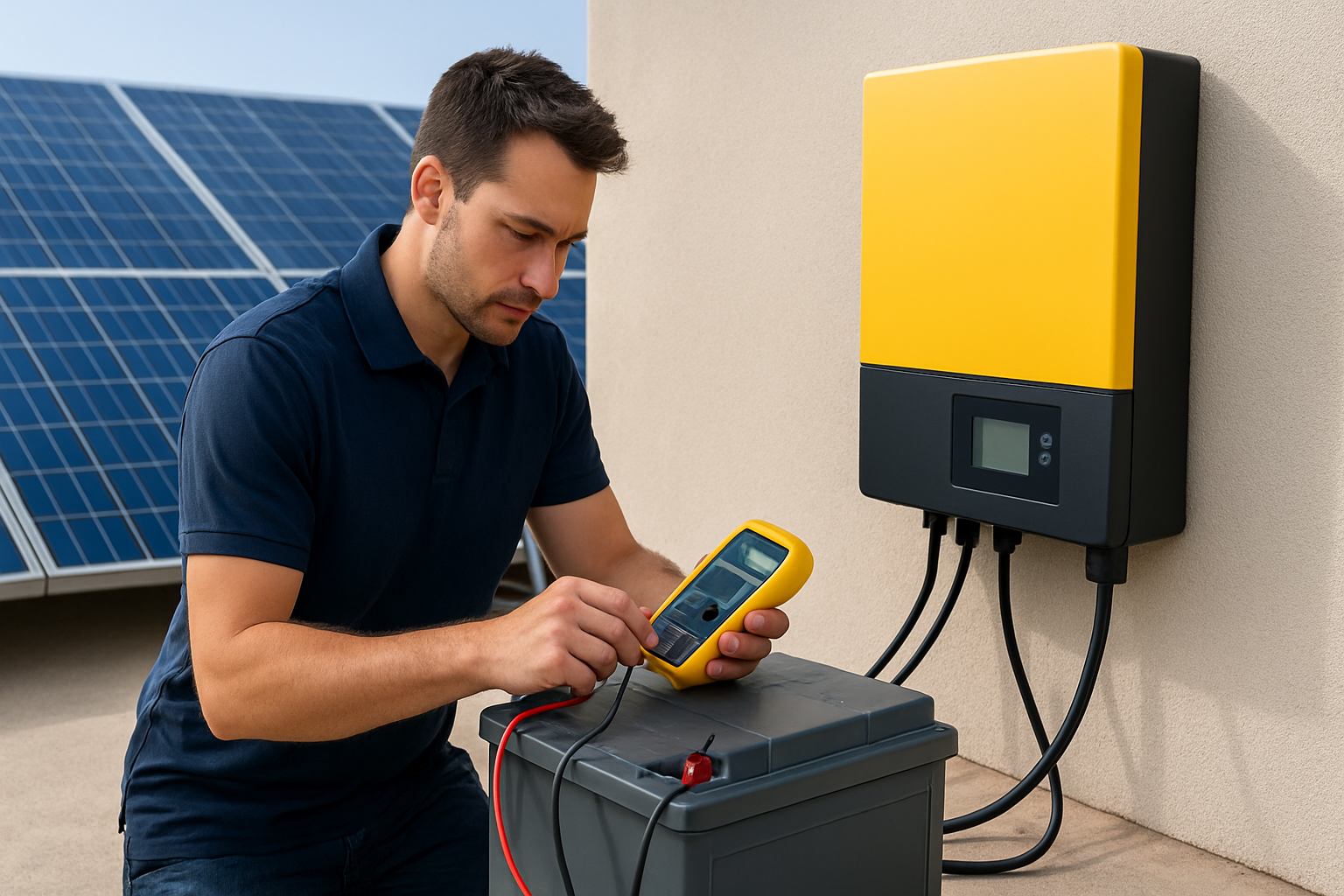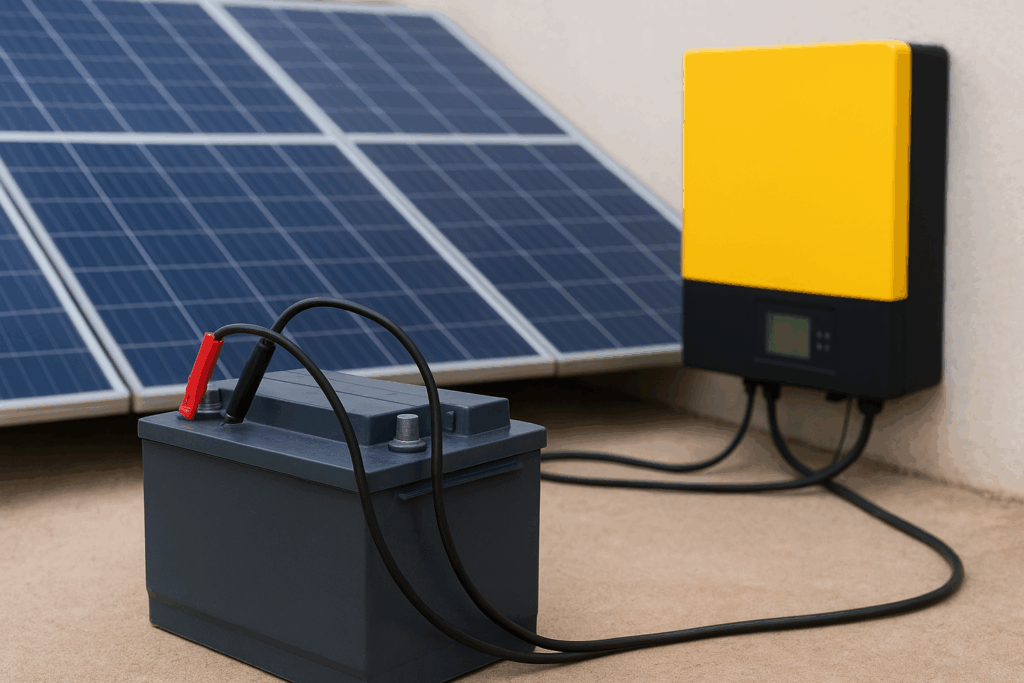Investing in solar power is a smart, sustainable decision — but maintaining the system properly is what guarantees lasting performance. One key component that needs special care is your solar battery. These energy storage units ensure you have power when the sun isn’t shining, but like all technology, they need consistent attention. Proper Solar Battery Maintenance can extend the lifespan of your batteries by years, enhance efficiency, and save you significant replacement costs in the long run.
Many homeowners mistakenly believe solar batteries are maintenance-free. While modern systems are low-maintenance, they still require regular inspection and basic upkeep to stay at peak performance. Whether you’re using lithium-ion, lead-acid, or gel batteries, following a few expert-approved steps can make all the difference.
In this guide, we’ll explore seven powerful Solar Battery Maintenance tips that every homeowner should follow to protect their investment, boost efficiency, and ensure continuous energy supply.
1. Regular Inspection: Catch Problems Before They Escalate
The first rule of effective Solar Battery Maintenance is regular inspection. Just like you’d check your car before a long drive, inspecting your solar battery helps you spot potential issues early.
Look for:
- Loose or corroded connections.
- Bulging or leaking battery casings.
- Low voltage readings or inconsistent charge levels.
Catching small problems before they worsen can save hundreds in repair costs. Check cables and terminals monthly for any signs of rust or dust buildup. Use a soft, dry brush to clean them gently.
If you notice any signs of corrosion, disconnect the power safely and clean the terminals using a mixture of baking soda and water. Keeping connections tight and corrosion-free ensures smoother current flow and better performance — a core part of professional Solar Battery Maintenance.
2. Keep Batteries Clean and Dust-Free
Cleanliness directly impacts battery health. A layer of dust might seem harmless, but it can trap heat and interfere with your solar battery’s ventilation. Dirt also attracts moisture, increasing the risk of rust or electrical shorts.
To clean your solar batteries:
- Turn off the system and disconnect safely.
- Wipe surfaces with a dry microfiber cloth or a cloth slightly dampened with mild soapy water.
- Avoid using any harsh chemicals or abrasive cleaners.
If your battery setup is outdoors, schedule monthly cleanings and install a weatherproof cover for extra protection.
Proper Solar Battery Maintenance through regular cleaning not only keeps your setup looking new but also improves performance and prevents overheating — especially in dusty or humid climates.
3. Maintain Optimal Temperature Conditions
Temperature plays a crucial role in your battery’s lifespan and efficiency. Most solar batteries operate best between 20°C to 25°C. Extreme heat accelerates chemical degradation, while extreme cold reduces storage capacity.
To ensure stable conditions:
- Keep batteries in a shaded, ventilated area.
- Avoid placing them near direct sunlight or heat-generating devices.
- For colder climates, use insulated enclosures or battery heaters.
Many battery failures occur due to temperature-related stress — something easily avoidable with mindful Solar Battery Maintenance. A temperature-controlled environment helps maintain voltage stability and prevents premature wear, ensuring consistent power output throughout the year.

4. Check Water Levels in Lead-Acid Batteries
If you’re using flooded lead-acid batteries, this step is non-negotiable. These batteries rely on a precise electrolyte balance to function efficiently. Low water levels can expose lead plates, causing permanent damage and reducing storage capacity.
Follow these steps for safe maintenance:
- Check water levels every 2–4 weeks.
- Only use distilled water — never tap water.
- Refill after the charging cycle, not before.
- Don’t overfill; leave room for expansion.
This step is often overlooked, but it’s one of the most crucial aspects of Solar Battery Maintenance for lead-acid systems. Proper hydration ensures balanced chemical reactions and prolongs your battery’s lifespan dramatically.
5. Monitor Battery Performance and Voltage Levels
Modern solar systems come with built-in monitoring tools that track voltage, charge levels, and energy flow. Regularly reviewing this data helps identify declining performance before it becomes a bigger issue.
If your system doesn’t include digital tracking, use a voltmeter or multimeter to check battery health manually. Most batteries should maintain a steady voltage between 12.4–12.7V when fully charged (for a 12V battery).
A drop below these levels indicates a possible issue. Consistent monitoring helps maintain optimal energy cycles — an essential part of reliable Solar Battery Maintenance.
Advanced systems also allow you to view insights through mobile apps or online dashboards, giving you real-time updates on performance and battery health.
6. Avoid Deep Discharge and Overcharging
Solar batteries are built to handle repeated charging and discharging cycles, but pushing them to extremes shortens their life. Overcharging causes excess heat and internal damage, while deep discharging (draining the battery completely) weakens storage capacity.
Here’s how to prevent it:
- Maintain charge levels between 20% and 80%.
- Use an MPPT charge controller to manage energy flow efficiently.
- Avoid connecting high-load devices when the battery is low.
Effective Solar Battery Maintenance includes managing charge cycles smartly. Lithium-ion batteries usually include built-in management systems, but for older or lead-acid types, manual monitoring is vital. Consistent, moderate charging ensures your system performs optimally for years.
7. Schedule Professional Maintenance Annually
While DIY maintenance is effective, nothing beats an annual inspection by certified solar professionals. They have tools and expertise to detect issues invisible to the untrained eye — from faulty wiring to declining cell efficiency.
A professional technician can:
- Test the battery’s state of charge (SoC) and capacity.
- Recalibrate sensors or monitoring systems.
- Clean electrical terminals and replace worn-out parts.
- Update software in smart hybrid systems.
Annual servicing might seem like an added expense, but it’s actually a long-term investment in safety and performance. Regular professional Solar Battery Maintenance ensures your system runs efficiently and prevents potential hazards like overheating or short circuits.

Comparison Table: Regular vs Neglected Solar Battery Maintenance
| Aspect | With Regular Solar Battery Maintenance | Without Maintenance |
|---|---|---|
| Battery Life | 8–12 years | 3–5 years |
| Efficiency | 90–95% | Drops to 60–70% |
| Cost Savings | High | Frequent replacements |
| Safety | Stable and secure | Risk of short circuits |
| Performance | Consistent | Unpredictable |
This simple comparison highlights why maintaining your solar battery system regularly is non-negotiable if you want consistent, safe, and long-term energy output.
Common Myths About Solar Battery Maintenance
Myth 1: “Solar batteries are maintenance-free.”
While lithium-ion batteries require minimal care, all batteries benefit from basic maintenance like cleaning and monitoring.
Myth 2: “All batteries perform the same.”
Different battery types — lithium-ion, lead-acid, and gel — have varying maintenance needs. Always follow the manufacturer’s recommendations for your specific model.
Myth 3: “Overcharging boosts battery capacity.”
In reality, overcharging accelerates wear and reduces lifespan. A charge controller helps prevent this, making it a must-have in every Solar Battery Maintenance setup.
Eco-Friendly Disposal and Recycling Tips
When your battery reaches the end of its life, don’t toss it in the trash. Improper disposal can release harmful chemicals into the environment. Instead:
- Contact your battery manufacturer for recycling programs.
- Drop old batteries at certified e-waste centers.
- Never mix damaged batteries with household waste.
Sustainable Solar Battery Maintenance includes responsible disposal and recycling. By doing so, you not only protect the planet but also support a cleaner renewable energy ecosystem.
DIY vs Professional Maintenance
| Type of Task | DIY Maintenance | Professional Maintenance |
|---|---|---|
| Cleaning & Dusting | ✔ | ✔ |
| Water Refill (Lead-Acid) | ✔ | ✔ |
| Voltage Testing | ✔ | ✔ |
| Performance Diagnosis | ❌ | ✔ |
| Software Update | ❌ | ✔ |
| Safety Inspection | ❌ | ✔ |
DIY care is perfect for routine tasks like cleaning and checking voltage. However, a professional’s touch once or twice a year ensures your system remains at peak health.
Final Thoughts
Your solar energy system is more than a sustainable investment — it’s your home’s power lifeline. With consistent Solar Battery Maintenance, you can ensure it stays efficient, reliable, and long-lasting.
Small actions — like cleaning terminals, maintaining temperature, and avoiding overcharge — collectively make a big impact. A well-maintained battery not only saves you money but also enhances your energy independence and peace of mind.
Treat Solar Battery Maintenance as an essential habit, not a chore. The effort you put in today ensures your solar power system continues to shine for many years ahead — keeping your home bright, sustainable, and energy-efficient.